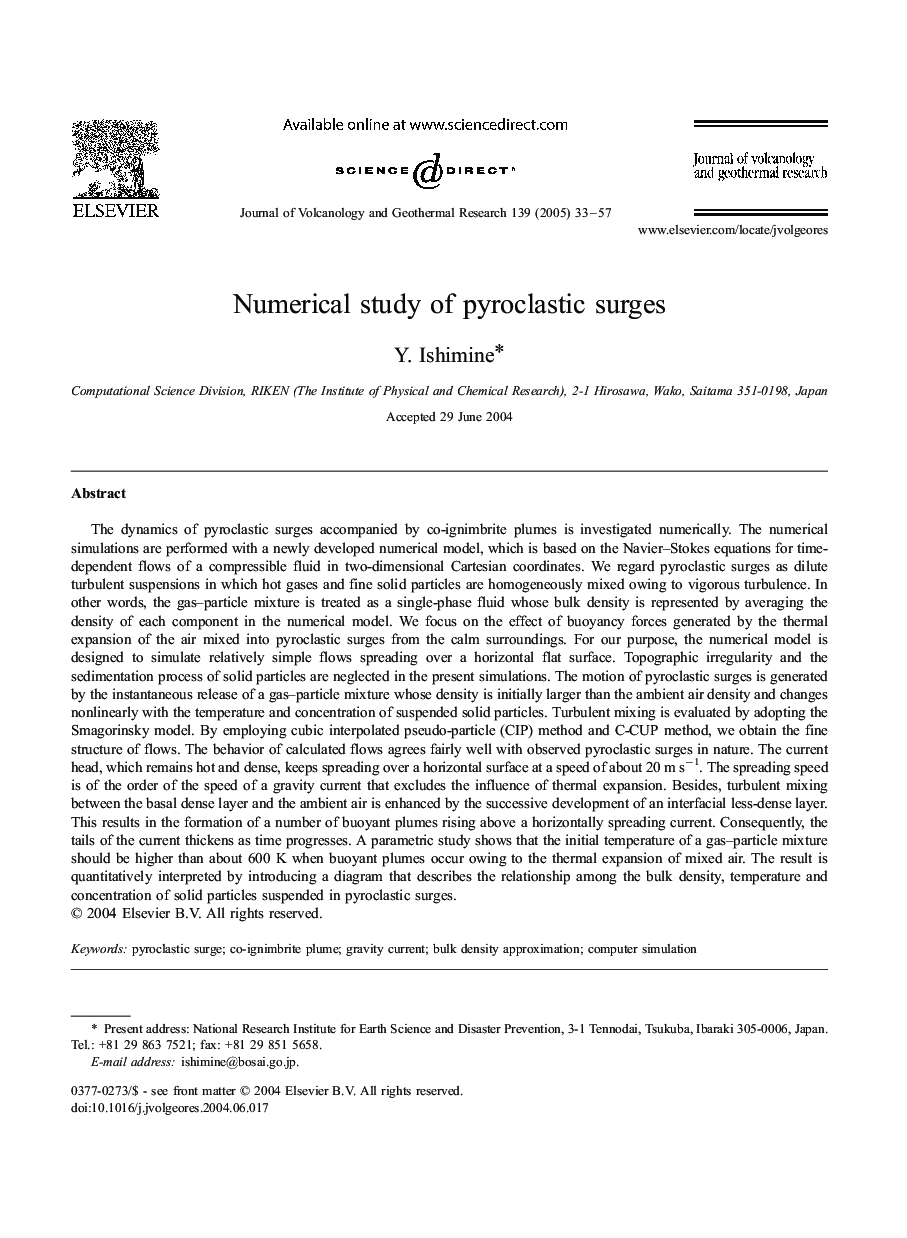| کد مقاله | کد نشریه | سال انتشار | مقاله انگلیسی | نسخه تمام متن |
|---|---|---|---|---|
| 9531183 | 1638504 | 2005 | 25 صفحه PDF | دانلود رایگان |
عنوان انگلیسی مقاله ISI
Numerical study of pyroclastic surges
دانلود مقاله + سفارش ترجمه
دانلود مقاله ISI انگلیسی
رایگان برای ایرانیان
کلمات کلیدی
موضوعات مرتبط
مهندسی و علوم پایه
علوم زمین و سیارات
ژئوشیمی و پترولوژی
پیش نمایش صفحه اول مقاله

چکیده انگلیسی
The dynamics of pyroclastic surges accompanied by co-ignimbrite plumes is investigated numerically. The numerical simulations are performed with a newly developed numerical model, which is based on the Navier-Stokes equations for time-dependent flows of a compressible fluid in two-dimensional Cartesian coordinates. We regard pyroclastic surges as dilute turbulent suspensions in which hot gases and fine solid particles are homogeneously mixed owing to vigorous turbulence. In other words, the gas-particle mixture is treated as a single-phase fluid whose bulk density is represented by averaging the density of each component in the numerical model. We focus on the effect of buoyancy forces generated by the thermal expansion of the air mixed into pyroclastic surges from the calm surroundings. For our purpose, the numerical model is designed to simulate relatively simple flows spreading over a horizontal flat surface. Topographic irregularity and the sedimentation process of solid particles are neglected in the present simulations. The motion of pyroclastic surges is generated by the instantaneous release of a gas-particle mixture whose density is initially larger than the ambient air density and changes nonlinearly with the temperature and concentration of suspended solid particles. Turbulent mixing is evaluated by adopting the Smagorinsky model. By employing cubic interpolated pseudo-particle (CIP) method and C-CUP method, we obtain the fine structure of flows. The behavior of calculated flows agrees fairly well with observed pyroclastic surges in nature. The current head, which remains hot and dense, keeps spreading over a horizontal surface at a speed of about 20 m sâ1. The spreading speed is of the order of the speed of a gravity current that excludes the influence of thermal expansion. Besides, turbulent mixing between the basal dense layer and the ambient air is enhanced by the successive development of an interfacial less-dense layer. This results in the formation of a number of buoyant plumes rising above a horizontally spreading current. Consequently, the tails of the current thickens as time progresses. A parametric study shows that the initial temperature of a gas-particle mixture should be higher than about 600 K when buoyant plumes occur owing to the thermal expansion of mixed air. The result is quantitatively interpreted by introducing a diagram that describes the relationship among the bulk density, temperature and concentration of solid particles suspended in pyroclastic surges.
ناشر
Database: Elsevier - ScienceDirect (ساینس دایرکت)
Journal: Journal of Volcanology and Geothermal Research - Volume 139, Issues 1â2, 1 January 2005, Pages 33-57
Journal: Journal of Volcanology and Geothermal Research - Volume 139, Issues 1â2, 1 January 2005, Pages 33-57
نویسندگان
Y. Ishimine,